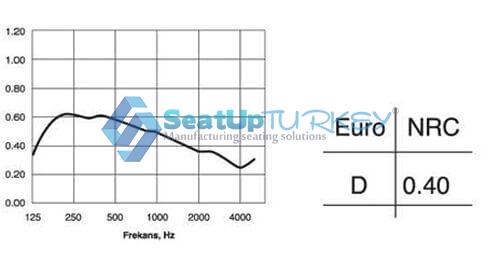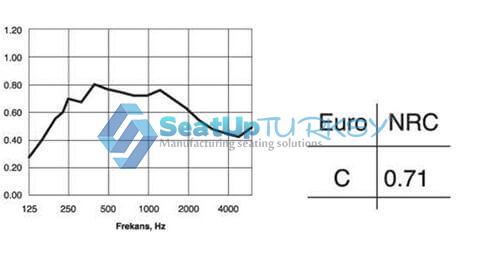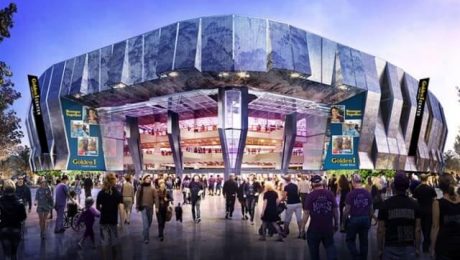Acoustic Wooden panels
Perforated acoustic panels provide a modern, light and luxurious look and enable cladding that enables high acoustic efficiency due to their structural features. Large plate finishing options according to project requirements. All the our acoustic panels are manufactured from quality raw materials, refractories according to the EN strictest standards.
In order to achieve good acoustic results in the spaces of the room with an impressive aesthetic combination the perforated acoustic panels are made of MDF plates with thickness of 3 options: 8mm,12mm,18mm (including a 0.2 mm thick black acoustic fabric in the behind), and are technically efficient in absorbing noise.
At the design level, the cladding panels provide a fine linear, qualitative and discrete aesthetic.
Suitable for halls with high acoustic requirements such as: Auditoriums, conference halls, Library and all other kind of public buildings.
Applications area: Wall and ceilings
Dimensions: for Ceiling: 600 x 600 mm – for Wall: 600 x 1200 mm or according to demend.
Panel thickness: 3 options: 8mm,12mm,18mm (including a 0.2 mm thick black acoustic fabric in the behind)
Materials: MDF 18 mm thick MDF base boards, possible finish in melamine or veneer for those who have the budget to invest in venner which is almost double price from the price of melamine finish.
How do I decide what is the right model for me from all the options ?
There are really a lot of our models of acoustic wooden panels, but what you need to do is first of all get a professional demand from an acoustic engineer that tells you that he is interested in some sort of acoustics and therefore you can choose a model that meets the requirements. Note that some of our models have a technical graph that indicates the acoustic quality of the panel to which it belongs, it is likely that your selection should be based on the appropriate graph.

Acoustima model 101 wooden panel

Acoustima101 Acoustic graph
 Acoustima model 102 Wooden panel
Acoustima model 102 Wooden panel

Acoustima102 Acoustic graph
Then color is an infinite option and any color that comes to mind is possible.
If you do not have a technical requirement from an acoustic engineer that restricts you to a particular model,
then we can say that in general when it comes to a site that requires a high level of acoustics and dealing with heavy noises, we suggest that you select a panel that is both channeled and perforated.
But if your site needs to deal with an area that is not very acoustically problematic then you can choose a model that is perforated only.
You see now without being an acoustic engineer you already can understand that wooden panels with both channeled and perforated have higher acoustic value from perforated only,
also you know that the acoustic value of those panels is getting increased by how much intense the perforating is, so holes size and their intensity level are aspect that influence on their acoustic performance.
If you know that there is no requirement for high acoustic performance but the requirement is more for Innovative and interesting design so go ahead with our models such as Acoustima model 224, or 225, 226 or 227 and etc which are adding beautiful scene to your site!!! for full catalog with all models download here, We are waiting your request.

Acoustima model 224

Acoustima model 225

Acoustima model 226

Acoustima model 227
- Published in Acoustic panel made in turkey, Acoustic panel manufacturer, Acoustic solutions, Acoustic wooden panel, Auditorium seating, cinema hall, conference seats manufacturer, Health, Perforated acoustic panels
Ready to walk to the end of the hall
Ready to walk to the end of the hall
Governors of states and mayors have become hostages in the hands of billionaire groups who use threats and promise to leave to obtain public funding for building larger, more elaborate, and sometimes over-exaggerated facilities
In recent years Sacramento fans have become accustomed to the fact that they lead nothing, unless it is chaos. The team, which is considered one of the blackest holes in the NBA and is synonymous with a failed management culture, is still looking for the path to professional success – and as long as Derrickos Cazins is in the car, one can believe that it will eventually find it too. The first step to success is in the city center, where what is supposed to be the most advanced basketball court in the world is now being built.
The change in question has not yet affected what is happening on the park, but it began as early as May 2013, when Yavak Rannadiv, an American Indian billionaire who made his fortune as a software engineer, purchased the club. Golden 1 Center is the name of the new hall, which is currently being built in downtown Sacramento, at a cost of $ 550 million, which will jump to more than $ 1 billion if one considers the businesses and residences to be included in the huge complex Which according to the plan is supposed to change the face of the capital of California.
Watch on youtube the Stadium of sacramento kings
The auditorium will contain 17,500 seats for viewers to enjoy the best of technology. In addition to graphic interfaces connected directly to the various social networks, green building will correspond with the vegetation of the region, huge hanger doors that welcome the visitors and lead to a public square overlooking a luxury hotel and a board that will hurt the eyes.
“We are helping Sacramento to become the city of the future,” Rannadiv told NBC radio in Sacramento. “Once the fan enters the compound, our smart system will recognize him if he wants to, and it will be his job to follow his whim.” She would do more, when she led him to his chair and knew which food he preferred. “This will be the smartest and greenest building in the world,” continues Rannadiv, who will also provide practical solutions such as information about the services with the shortest turn, how long it will take to buy a cup of cola and the estimated time of departure at the end of the game.
While Chernadiv boasts of his team’s new and smart home, which is expected to be ready in 17 months, not everyone is satisfied with the ostentatious project, which is largely financed by public money. Funding for the sports stadiums has been in the headlines in the United States in recent years. While supporters argue that the money is directed to theaters and stadiums that encourage the economy and develop social and cultural life, opponents say there is no reason why countries and municipalities, most of which are in deficit, will finance sports halls owned by billionaires.
watch on youtube the Milwaukee Ripple Effect
The studies support the opponents’ position. While a new room may have a positive effect on trading in nearby areas, it is difficult to find the same effect in areas far from it. A recent study in Forbes examined the impact of the baseball stadiums built in Baltimore, San Diego, San Francisco, Denver, and Seattle on the local economy for 25 years. The study found no evidence that the stadiums improved the local economy, given that the money allocated for the construction could have been invested in more appropriate channels such as education, welfare and housing.
“We’re building a hall for two of the richest people in the United States,” said Jonathan Brustoff, a Wisconsin lawmaker, to the New York Times. “If aliens came here and saw what was happening, they would say, ‘What the hell are you doing? ‘”. “The owners of the group acted as if they had no obligation to the local people,” added David Bowen, also from the Wisconsin Commons. Tim Shea, the head of the Milwaukee Chamber of Commerce, believes that the hall in the city will soon contribute to the city’s life, and not necessarily in the economic context: “It gives the city an identity and uniqueness,” he explained. Which only a few weeks earlier had signed a $ 250 million cut in the University of Wisconsin budget.

Simulation of “Golden 1 Center”. The auditorium will contain 17,500 seats for viewers to enjoy the best of technology
Milwaukee is just the latest example of a city that has succumbed to billionaire demands and has given them hundreds of millions of dollars. While in Sacramento, Rannadiv enjoyed the support of Mayor Kevin Johnson, a former NBA player, the Bax owners, Wesley Addens and Mark Lasry, had to threaten to receive government money. The two really did not invent the method. Most of the sports stadiums in the top four leagues were established with public funding. Forbes reported that between 2000 and 2010, the American public invested at least $ 12 billion in halls and tools. As well as the profits already generated from the halls – mainly through sponsorship agreements and franchises for food sales – from the groups’ collections to their pockets. The only payment that the state receives back is annual fees, which will cover the investment in hundreds of years.
While the owners of sports teams in the United States enjoy both lucrative and lucrative business and public funding that helps them increase future revenue, state governors and mayors remain hostage. In recent years, NBA players have begun to play a special game – “Give me a hall, or I leave for Seattle,” call it, and billionaires, as the billionaires do, do not stop forever.
No public figure is interested in signing the departure of a professional sports team. Seattle is still struggling to recover from the SuperSonics’ departure in 2008, and Los Angeles has yet to overcome the departure of Rames in 1995. Therefore, these two cities are used as leverage by group owners. “Who will be the next group to pretend to be going to Seattle unless the city does not pay for its shiny new room?” Bill Simmons said on Twitter. “It’s amazing that 2015 billionaires are still able to push cities and countries to build them.” As it seems, this crooked reality is unlikely to change anytime soon.
Now watch what John Oliver has to say about the stadiums in the United States
Experts: The new stadiums will not solve the problems of Italian clubs
Experts: The new stadiums will not solve the problems of Italian clubs
More than 20 football clubs in Italy plan to build their own stadium or renovate existing stadiums. But a new stadium, although it may raise revenues by 40%, is not the solution to the problems



